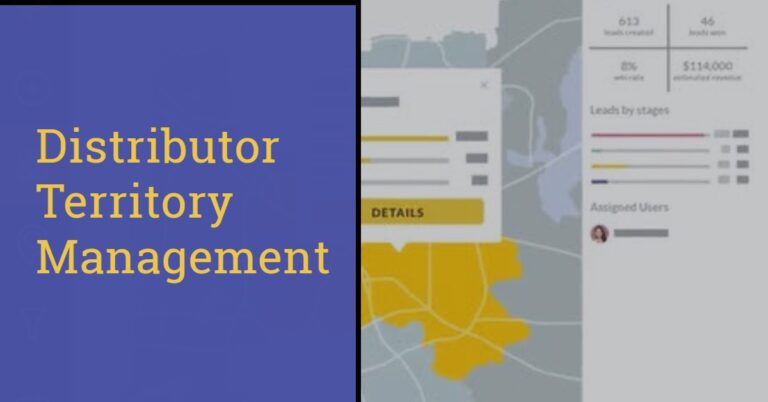It doesn’t matter what you sell, territory management is essential to your success.
This is especially true in the distribution industry. Proper territory management will help your sales team optimize sales coverage, provide better customer service, boost efficiency, and more. The question is, how do you manage your territories effectively? That’s what we’ll discuss in this article!
Read on to learn everything you need to know about territory management for distributors, including its importance, key factors to consider, and best practices to make sure things go smoothly.
The Importance of Territory Management for Distributors
Effective territory management can have a significant impact on your sales numbers.
This is because success in this area often leads to streamlined operations, better customer service, and more sales opportunities. Let’s take a close look at each of these important benefits:
Streamlined Operations
Sales territory management will help you balance your sales resources appropriately.
For example, you can reduce travel time for busy reps by focusing their efforts on specific geographical areas. This will make them more efficient, and save your company money in travel-related expenses.
Proper territory management also accounts for market potential. By aligning reps’ sales capacity with the number of buyers in a certain area, you’ll ensure each rep maintains peak productivity. After all, they’ll have plenty of prospects to contact, but not so many that they get bogged down in minor details.
Better Customer Service
As mentioned above, territory management prevents distribution companies from overextending their sales teams. This means reps can respond to inquiries quicker, leading to higher customer satisfaction.
Also worth mentioning, territory management is a form of segmentation, which will enable your reps to implement personalized sales plans. For example, reps can learn about the specific pain points and behaviors of prospects in their territory—then devise custom strategies to win new business.
Increased Sales Opportunities
Lastly, territory management for distributors often leads to more sales.
How so? It’s pretty simple: effective territory management allows sales reps to spend more time finding quality prospects, catering to existing customers, and uncovering new opportunities.
This is all possible because reps receive balanced workloads. As such, they aren’t responsible for an unrealistic number of prospects/customers and can better serve their target audience.
Key Factors to Consider For Distributor Sales Teams
As you can see, the benefits of sales territory optimization are impressive.
Of course, you have to cut your territories the right way to enjoy these benefits. Otherwise, you and your sales team will experience the same challenges you already do.
Thankfully, territory management for distributors supports a wide range of market segments, including customer size and geography, as well as specific product types and customer needs. You just need to focus on a few key factors to find success. Those key factors are:
Market Potential
Market potential can be defined as the revenue a certain territory could generate.
A territory’s market potential is typically influenced by demographics, such as population and income levels. Though, it should be said that broader industry trends can affect market potential as well.
To succeed at territory management for distributors, your reps need to understand their territories, AKA the greater metropolitan areas they’ve been assigned. When they grasp customer buying habits and trade patterns in their specific territories, they’ll be able to optimize their sales strategies and close more deals.
Your competition can also impact market potential. Fortunately, you can overcome this challenge by training reps to showcase your company’s unique advantages to potential customers.
Sales Team Capabilities
Think about the reps on your sales team. Which of them is most likely to close a big deal for your team?
Generally speaking, the most successful sales reps are the ones who spend the most time selling. In other words, they’re reps who minimize admin tasks—often through the smart use of technology. These are the reps that should be assigned to the areas with the highest sales potential.
But this isn’t the only factor to consider. The strengths of your sales reps should also be matched to the needs of each territory. Together, these two rules of thumb will help your company drive more revenue.
Finally, account for rep capacity. Rep A might be the best pure salesperson on your team. But if they’re already swamped with other prospects, you should probably assign new leads and/or territories to Rep B.
In a nutshell, effective territory management pairs top sellers with high-potential sales areas, while accounting for territory needs, as well as each individual rep’s strengths and current workload.
Geographical Constraints
Last but not least, consider the physical space you ask your reps to manage.
Territory size is an important factor. Large areas usually contain more prospects and take longer to traverse, both of which could lead to less productivity and higher travel expenses.
There’s no hard and fast rule for territory size. Just make sure that your reps aren’t overwhelmed by potential customers and can serve each of them in the ways they deserve.
We should also talk about the unpredictability of field sales. A prospect might cancel a meeting with one of your reps. Another meeting might run longer than your rep intended.
When reps have the right insights (like the insights available in SPOTIO), they can maximize their time in the field. When meetings get canceled, for example, reps can access the SPOTIO mobile app, pinpoint other opportunities in their territory, and make a spontaneous visit to a different potential customer. Doing so will help reps stay productive—but it’s only possible if territories are designed correctly.
Territory Management Best Practices For Distributors
Territory management for distributors isn’t rocket science. But it does require a strategic approach. The best practices below will keep you and your sales department on the right track:
Clearly Define Each Territory
Your reps should never think, “Wait, where does my territory end again?” They should have clearly defined borders. Luckily, you can define said borders in a myriad of ways. For example, there are:
- Geographic boundaries
- Industry boundaries
- Revenue boundaries
- Product boundaries
In other words, you can define territory boundaries however you want. Just make sure that the parameters you choose make sense for your company and are explicitly clear to your sales reps.
Segment High-Value Sales Territories
Once you’ve decided how you want to segment territories, you can pinpoint high-value areas.
A “high-value” area is a territory with a lot of sales potential. You want to assign these locations to your best available reps. Just remember, “best” is relative. Your highest revenue earner might not be an ideal fit if they specialize in enterprise sales and the territory in question is geared towards small businesses.
Also, like we talked about in a previous section, you don’t want to overwhelm your salespeople. One of your reps might be perfect for a certain territory. But if they’re already busy with other prospects you should give the territory to someone else on your team. Or, at the very least, assign the first rep’s current prospects to another seller so they can focus their energy on the new territory you want to give them.
Focus On Existing Customers
Most sales departments put a special focus on finding and converting new leads. But don’t forget about your existing customers. These people/companies are potential goldmines for two reasons:
- They’ve already purchased your product(s). If they enjoyed the process, they’re much more likely to buy from you again—and you won’t have to go through the same song and dance as before.
- They can provide you with cheap, high quality leads, AKA referrals. Referred leads are more likely to buy from you than cold leads because there’s built-in trust. Don’t forget to ask for referrals!
Tools like SPOTIO make it easy to visualize existing customers on a visual map. Doing so will make it much easier to draw territories that include previous buyers, and thus increase your referral rate.
Balance Rep Workloads
When it comes to territory management for distributors, balanced workloads are essential.
Strike out in this area and some of your reps will be so bogged down by prospects they’ll make mistakes. Said mistakes could lead to missed opportunities, lost sales, and a tarnished reputation.
Other reps won’t have enough prospects to sell to, which will lead to discontentment. Said discontentment could lead to department in-fighting. Friendly competition between sales reps is a good thing. (Side note: foster competition with leaderboards.) But an all-out war for potential customers is very, very bad.
The best way to avoid these two scenarios is to simply cut and assign territories equally. That way every rep has the proper amount of prospects and existing customers to serve and sell to.
Set Territory Sales Targets
You’ve cut new territories and assigned them to the appropriate reps. Now what? Give each territory a specific sales target, so each rep knows what success looks like.
Your goals can be quantitative or qualitative. An example of a quantitative goal would be, “Close 10 deals per quarter.” An example of a qualitative goal would be, “Build quality relationships in the area.”
To develop sales targets, consider your overarching mission and the data available to you. If you’re trying to break into a new area, building relationships might be a good goal. But if you want to focus on sales, consider the number of prospects and competitors in each territory, as well as your rep’s close rate.
Monitor Rep and Territory Performance
You’ve assigned all territories to your reps. Now you can sit back and relax, right? Not quite…
You need to monitor individual rep and territory performance. Are your territories generating as many sales as you thought they would? Which one is performing best? Do your reps feel over or under worked?
These are important questions. By monitoring performance, you can answer them with confidence. Then you can make necessary adjustments to achieve company goals more consistently.
Regularly Review and Adjust Territories
Don’t just monitor rep and territory performance, as we suggest above. Act on the information you glean. Put another way, review and adjust your territories on a regular basis.
You may find that Territory A has more prospects than you thought, and the rep you assigned to the territory is drowning. You should probably split that territory in half and assign part of it to another rep.
You should also monitor the way your reps spend their time with each customer.
Why? Because every customer has unique needs. One might need to renew their contract or subscription with your company. Another might have been MIA for the past nine months.
The way reps approach these two customers should be different. Good news: when reps have access to in-depth territory data, they can make real-time adjustments to their sales processes. Doing so will help them close more deals, leading to greater personal and organizational success.
Tools like SPOTIO make it super easy to monitor the metrics that matter to your organization. You can then use that data to reconfigure territories when needed—all within the SPOTIO platform.
Manage Your Sales Territories With SPOTIO
If you want to succeed in the distribution industry, you need to learn effective territory management for distributors. Don’t worry, after reading this article, you have all the information you need. All there is to do now is implement the tips, tricks, and best practices we covered in the sections above.
Know what else will help you manage your territories? SPOTIO!
Our platform makes it easy to cut territories based on geographic boundaries or by drawing on a map. Once a territory is cut, you can quickly assign it to a rep, then monitor their performance. The result? Zero territory overlap between reps and exact data you can use to achieve team-wide success.
Sign up for a free demo of SPOTIO right now to learn if it’s the right tool for your sales team.



